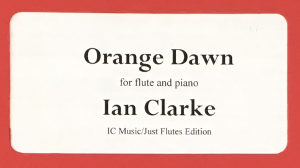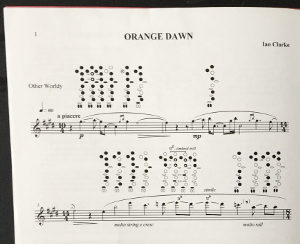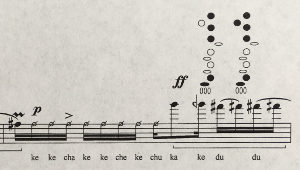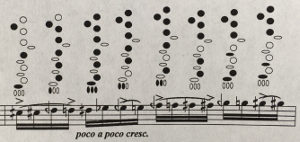So have you tried extended techniques? Or…are you afraid?
Sometimes extended techniques can be quite intimidating to the uninitiated. But, you know what? If you just try, you might actually have a lot of fun playing them.
I went through a good deal of my performing and teaching career without an extended technique to my name.
And I was quite happy without it all.
Now, to be fair, extended techniques weren’t really the thing for quite awhile. Then when those niggly little new techniques started taking over the flute world, I thought I would just ignore them.
I was a purist, of course.
Those techniques were for others. Those techniques were not for purists like me, that want only classical music. Harrumph.
But one day I couldn’t stem the tide. It may have been after I’d had 4 children in 5 years and was on a sort of hiatus from performing. Or it may be that one night I woke up (probably from a baby) and realized that I was being left in the dust and that if I didn’t begin figuring this business out, that I would not be able to teach students who were more interested in these techniques.
Now who wants that?
My first step was to chose a piece. Baby steps, Baby steps. I chose Ian Clarke’s Orange Dawn.

Now, I know, you people that have taken extended techniques to the nth degree probably think that was not a huge stretch. But listen, for me this was monumental!
It can happen, that when you first look at a piece with extended techniques out the wazoo, you might swoon or hyperventilate or just put it away for another day. When I first looked at all the alternate fingerings for the first page of Orange Dawn I about hyperventilated.
It is much like when I look at my little girls’ bedroom. I immediately close the door again and go about my business trying to erase that picture from my mind. Or I might have run the other direction screaming.
But like the first page on any piece, once seen, you cannot un-see it.

And so it happened that way with Orange Dawn. I realized that I wouldn’t learn it until I programmed it for a recital. We all know that once you have a program in mind, you go for it. So once it was “on the program” I knew I had to tackle it.
So yada, yada yada, I learned the piece.
And it wasn’t so bad.
What I learned was that you don’t work on the whole piece all at the same time. Much like my girls room where the only way to tackle it is to look at one corner and tell yourself “I can clean that corner…” Once it’s clean you look at another small area and clean that. Little by little the room gets cleaner. The cleaner it gets, the more enthusiasm you have to finish it.
And so it goes with any new extended techniques. Look only at one page at a time, not the entire piece. Conquer that one page. Then turn the page. In the end, you’ll find it’s not so bad.
When I got over my initial horror at the sight of the extended techniques in Orange Dawn, I had a great time with that piece. In this day and age you can find recordings of any piece you are working to help you understand what is the goal sound.
I was so energized by learning Orange Dawn, that for my next recital I programmed Zoom Tube!

Let’s not talk about the joyous “yow” of all things, that made my blood run cold. But I did it! If you don’t know this piece go look it up. It’s great fun!

Now, I’m all in. ALL. IN. I’ll play anything. I beat-box, tongue stop, do weird multiphonics. I program these pieces for every recital whether in solo, or chamber. I’ve listed a couple chamber pieces that I’ve performed in the favorite things tab at the top.
Don’t be afraid! Join the revolution. Extended techniques are fun, fresh, and for everyone! You can do it.
Pick a piece and begin!
Have Fun,
DoctorFlute
